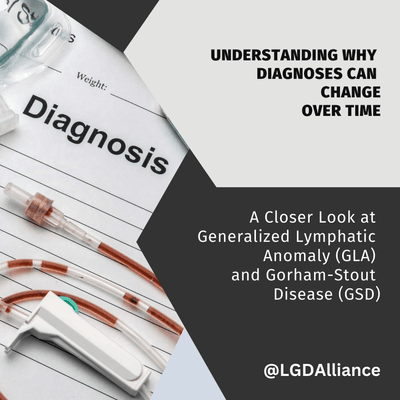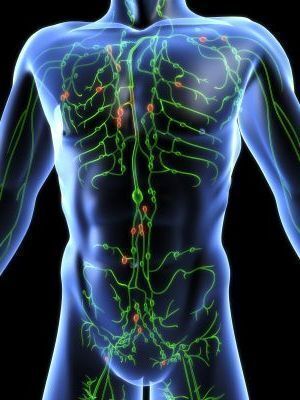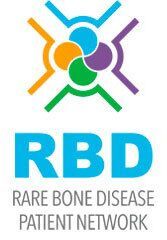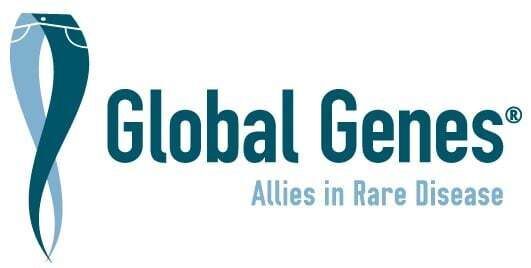
Understanding the Evolution of CLA: A Closer Look at Generalized Lymphatic Anomaly (GLA) and Gorham-Stout Disease (GSD)
In the world of rare diseases, receiving a diagnosis can be both a relief and a challenge. For many patients, a diagnosis provides answers and a path forward. However, as medical science advances, these diagnoses can evolve, leading to new understandings of the conditions they describe. This is particularly true for patients diagnosed more than a decade ago, whose initial diagnosis might be reassessed in light of new genetic discoveries and a deeper understanding of the disease. Such is the case with Generalized Lymphatic Anomaly (GLA) and Gorham-Stout Disease (GSD), two rare but often confusingly similar conditions. In this blog, we'll explore how these diseases are distinguished, why diagnoses can change over time, and the crucial role that genetic testing plays in ensuring patients receive the right treatment.
Diagnoses Then and Now: The Evolution of Medical Understanding
Fifteen years ago, the tools available to diagnose CLAs were far less advanced than they are today. Doctors primarily relied on clinical observations and imaging studies to identify and differentiate conditions. While this approach was the best available at the time, it sometimes led to misdiagnoses or broad categorizations that didn't fully capture the nuances of a patient's condition.
With the advent of more sophisticated genetic testing, doctors now have the ability to pinpoint the exact molecular drivers behind many diseases. This has led to the reclassification of certain conditions and, in some cases, the identification of entirely new diseases. For patients who received a diagnosis years ago, this means their current symptoms might now align more closely with a different or more specific condition. This is exactly what can happen with GLA and GSD—two conditions that, while sharing some similarities, have distinct genetic and clinical profiles.
Generalized Lymphatic Anomaly (GLA)
Formerly known as Lymphangiomatosis, Generalized Lymphatic Anomaly (GLA) is characterized by widespread lymphatic malformations that can affect soft tissues, bones, and various organs, including the spleen. While GLA can be present from birth, it is most often diagnosed during childhood or young adulthood. One of the hallmark features of GLA is the presence of lymphatic malformations in multiple areas of the body.
Bone involvement is common in GLA, particularly in the ribs and spine. However, unlike GSD, GLA does not typically affect the cortical bone, which is the dense outer layer of bones responsible for structural integrity. Fractures are uncommon in GLA, and the disease usually does not result in progressive bone loss. Instead, patients with GLA may experience symptoms related to fluid accumulation in the body, such as pericardial or pleural effusions, as well as issues like protein-losing enteropathy and leukopenia. At the genetic level, GLA is often associated with activating somatic variants in the PIK3CA gene. This gene is involved in cell growth and division, and mutations in PIK3CA have also been implicated in other diseases, including some forms of cancer and PIK3CA-related overgrowth spectrum (PROS).
Gorham-Stout Disease (GSD)
Gorham-Stout Disease (GSD), often referred to as "vanishing bone disease," is a rare condition characterized by the progressive loss of cortical bone. Unlike GLA, GSD can progress rapidly, though in some cases it may spontaneously stabilize. GSD typically starts at a specific site but often spreads to involve adjacent bones. The condition is most commonly found in the axial skeleton, which includes the skull, spine, and ribcage.
The bone loss in GSD is driven by the migration and proliferation of lymphatic endothelial cells (LECs) into the bone tissue, leading to the breakdown and absorption of the bone. This can result in a range of symptoms, depending on the extent and location of the bone loss. Pathologic fractures are common in GSD, as are complications like pleural effusions and cerebrospinal fluid leaks, particularly when the skull or spine is involved.
Genetically, GSD is associated with activating somatic variants in the KRAS gene. Like PIK3CA, KRAS is also involved in cell growth and division, and mutations in this gene are linked to several types of cancer and other vascular anomalies.
Similarities and Differences Between GLA and GSD
While GLA and GSD share some clinical features, such as the involvement of the lymphatic system and the potential for effusions in body cavities, they are fundamentally different in several key ways:
- Bone Involvement: GLA typically affects multiple bones but does not usually involve the cortical bone, and fractures are rare. In contrast, GSD is characterized by the progressive loss of cortical bone, leading to frequent fractures and bone loss.
- Genetic Mutations: GLA is most commonly linked to mutations in the PIK3CA gene, while GSD is associated with mutations in the KRAS gene. These genetic differences are critical for diagnosis and treatment, as they point to different underlying mechanisms driving the diseases.
- Disease Progression: GLA is often more stable and less likely to cause severe complications related to bone structure, whereas GSD can lead to significant bone loss and associated complications, such as fractures and fluid leaks.
The Importance of Genetic Testing
Given the overlap in symptoms and the potential for misdiagnosis, genetic testing has become an essential tool in differentiating between GLA and GSD. Identifying the specific genetic mutation responsible for a patient's condition not only helps confirm the diagnosis but also guides treatment decisions. For example, targeted therapies that inhibit the PIK3CA pathway may be effective in treating GLA, while therapies aimed at the KRAS pathway could be more appropriate for GSD.
For patients who received a diagnosis years ago, revisiting their case with modern genetic testing can be crucial. Not only does it provide clarity, but it also opens the door to more effective treatments tailored to their specific condition. As our understanding of complex lymphatic anomalies continues to grow, the ability to refine and update diagnoses will remain a key component of patient care.
Conclusion
The journey of receiving and living with a diagnosis of a rare disease like GLA or GSD is challenging, but advances in genetic research are continually reshaping our understanding of these conditions. For patients who were diagnosed many years ago, these advances may mean a re-evaluation of their diagnosis and, potentially, new and more effective treatment options. Genetic testing plays a pivotal role in this process, offering a clearer picture of the disease and guiding patients and doctors toward the best possible care.











